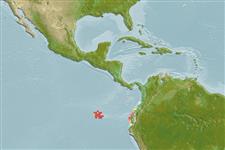>
Blenniiformes (Blennies) >
Tripterygiidae (Triplefin blennies) > Tripterygiinae
Etymology: Lepidonectes: Greek, lepis = scale + Greek, nektos = swimming (Ref. 45335).
Environment: milieu / climate zone / depth range / distribution range
Ekologi
laut berasosiasi dengan karang; kisaran kedalaman 1 - 12 m (Ref. 5227). Tropical
Southeast Pacific: endemic to the Galapagos Islands.
Size / Weight / umur
Maturity: Lm ? range ? - ? cm
Max length : 8.9 cm SL jantan/; (Ref. 5227)
Adults live in rocky reefs, boulder strewn slopes and walls (Ref. 5227). Males occupy territories of less than 50 cm diameter, on vertical or overhanging rock faces, from November through February. Females leave the territory after spawning, but the male continues to court and to spawn with other females in his territory while guarding the previously spawned egg masses from predators like wrasses and gobies (Ref. 28023). Eggs are hemispherical and covered with numerous sticky threads that anchor them in the algae on the nesting sites (Ref. 240). Larvae are planktonic which occur primarily in shallow, nearshore waters (Ref. 94114).
Allen, G.R. and D.R. Robertson, 1994. Fishes of the tropical eastern Pacific. University of Hawaii Press, Honolulu. 332 p. (Ref. 11482)
Status IUCN Red List (Ref. 130435)
ancaman kepada manusia
Harmless
penggunaan manusia
informasi lanjut
Umur / SaizPertumbuhanpanjang-beratpanjang-panjangukuran frekuensiMorfometrikMorfologiLarvaDinamika larvapemulihanKelimpahanBRUVS
AcuanBudidaya airprofil budidaya airStrainGenetikaElectrophoresesDiturunkanPenyakit-penyakitPengolahanNutrientsMass conversion
mitraGambarStamps, Coins Misc.Suara-suaraCiguateraKecepatanTipe renangArea insangOtolithsOtakPenglihatan / visi
Alat, peralatan
laporan khas
muat turun XML
Sumber internet
Estimates based on models
Preferred temperature (Ref.
123201): 23.5 - 25.6, mean 23.9 °C (based on 19 cells).
Phylogenetic diversity index (Ref.
82804): PD
50 = 0.6250 [Uniqueness, from 0.5 = low to 2.0 = high].
Bayesian length-weight: a=0.00562 (0.00258 - 0.01228), b=3.08 (2.89 - 3.27), in cm total length, based on LWR estimates for this (Sub)family-body shape (Ref.
93245).
Trophic level (Ref.
69278): 2.6 ±0.2 se; based on size and trophs of closest relatives
Daya lenting (Ref.
120179): Tinggi, Waktu penggandaan populasi minimum kurang dari 15 bulan (Preliminary K or Fecundity.).
Fishing Vulnerability (Ref.
59153): Low vulnerability (10 of 100).
Nutrients (Ref.
124155): Calcium = 198 [102, 360] mg/100g; Iron = 1.06 [0.58, 1.79] mg/100g; Protein = 18.5 [17.3, 19.6] %; Omega3 = 0.0956 [, ] g/100g; Selenium = 28.8 [12.6, 65.4] μg/100g; VitaminA = 85.3 [26.7, 260.9] μg/100g; Zinc = 2.38 [1.50, 3.56] mg/100g (wet weight);
